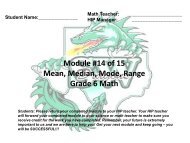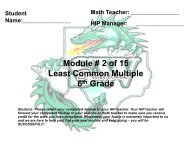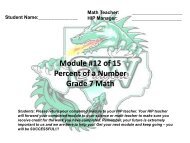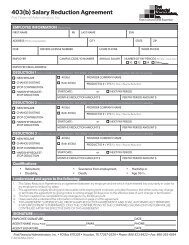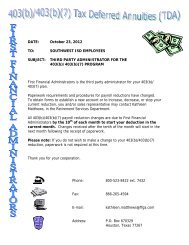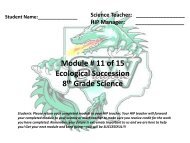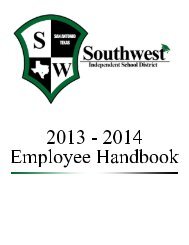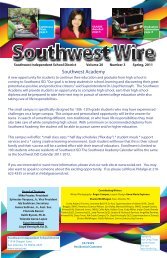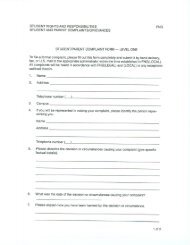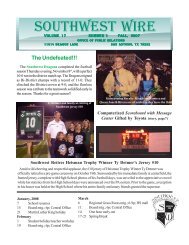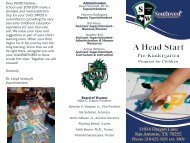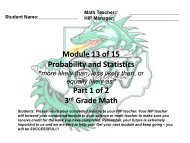Module 12 of 12 Applying the Pythagorean Theorem and Applying ...
Module 12 of 12 Applying the Pythagorean Theorem and Applying ...
Module 12 of 12 Applying the Pythagorean Theorem and Applying ...
Create successful ePaper yourself
Turn your PDF publications into a flip-book with our unique Google optimized e-Paper software.
Student Name:_______________<br />
Math Teacher: ___________________<br />
HIP Manager: ___________________<br />
<strong>Module</strong> <strong>12</strong> <strong>of</strong> <strong>12</strong><br />
<strong>Applying</strong> <strong>the</strong> <strong>Pythagorean</strong> <strong>Theorem</strong> <strong>and</strong><br />
<strong>Applying</strong> Math in Everyday Life<br />
8 th Grade Math<br />
Students: Please return your completed module to your HIP teacher. Your HIP teacher<br />
will forward your completed module to your science or math teacher to make sure you<br />
receive credit for <strong>the</strong> work you have completed. Remember, your future is extremely<br />
important to us <strong>and</strong> we are here to help you! Get your next module <strong>and</strong> keep going – you<br />
will be SUCCESSFUL!!!
Introduction to <strong>Applying</strong> <strong>the</strong> <strong>Pythagorean</strong> <strong>Theorem</strong>
More Introduction to <strong>Applying</strong> <strong>the</strong> <strong>Pythagorean</strong> <strong>Theorem</strong><br />
It is important to remember when working with <strong>the</strong> <strong>Pythagorean</strong> <strong>Theorem</strong> that <strong>the</strong> legs<br />
are always labeled a <strong>and</strong> b. It doesn’t matter which you choose for a or b, but <strong>the</strong>y<br />
must be on <strong>the</strong> legs <strong>of</strong> <strong>the</strong> right triangle. The hypotenuse, <strong>the</strong> longest side <strong>of</strong> <strong>the</strong><br />
triangle is always going to be labeled as c.<br />
I think that it is important that we also look at ano<strong>the</strong>r method for applying<br />
<strong>the</strong> <strong>Theorem</strong>. It still requires that you label <strong>the</strong> legs <strong>and</strong> hypotenuse correctly,<br />
but allows you to usually solve <strong>the</strong> problem without making mistakes with <strong>the</strong> formula.<br />
Essentially, what <strong>the</strong> <strong>Pythagorean</strong> <strong>Theorem</strong> is stating to us<br />
is that when we add <strong>the</strong> squares <strong>of</strong> <strong>the</strong> two legs,<br />
<strong>the</strong> sum will equal <strong>the</strong> square <strong>of</strong> <strong>the</strong> hypotenuse.<br />
To prove it to ourselves, we will use <strong>the</strong> same image,<br />
but we will give it some nice easy numbers, <strong>the</strong> first<br />
<strong>Pythagorean</strong> Triple 3, 4, <strong>and</strong> 5.<br />
Looking at <strong>the</strong> squares <strong>of</strong> <strong>the</strong> two<br />
legs, we have areas <strong>of</strong> 9 <strong>and</strong> 16.<br />
The sum <strong>of</strong> 9 <strong>and</strong> 16 is 25, which<br />
is equal to <strong>the</strong> area <strong>of</strong> <strong>the</strong> square<br />
<strong>of</strong> <strong>the</strong> hypotenuse.
Example 1<br />
A contractor is building a basement. He pours <strong>the</strong> walls <strong>of</strong><br />
<strong>the</strong> foundation <strong>and</strong> <strong>the</strong>n checks to make sure <strong>the</strong> walls are<br />
perpendicular. The length <strong>of</strong> <strong>the</strong> basement is 60 feet. The<br />
width <strong>of</strong> <strong>the</strong> basement is 45 feet, <strong>and</strong> <strong>the</strong> diagonal is 75 feet.<br />
Do his measurements indicate <strong>the</strong> walls are perpendicular?<br />
How do you know?
Example 2<br />
A door has <strong>the</strong> dimensions shown at <strong>the</strong> right. Is <strong>the</strong> angle<br />
opposite <strong>the</strong> diagonal a right angle? Round to <strong>the</strong> nearest tenth.<br />
Question: I need to…<br />
Information: The legs <strong>of</strong> <strong>the</strong> triangle are ____ ft. <strong>and</strong> ____ ft. The hypotenuse<br />
(diagonal) is ____ ft.<br />
Plan: Use <strong>the</strong> converse <strong>of</strong> <strong>the</strong> <strong>Pythagorean</strong> <strong>Theorem</strong> to prove that it is or isn’t a right<br />
triangle that is formed by <strong>the</strong> diagonal.<br />
Solve: Find <strong>the</strong> size <strong>of</strong><br />
all <strong>of</strong> <strong>the</strong> square on <strong>the</strong><br />
right triangle formed by<br />
<strong>the</strong> diagonal <strong>of</strong> <strong>the</strong> door.<br />
The areas <strong>of</strong> <strong>the</strong> two green<br />
squares should add up to<br />
<strong>the</strong> area <strong>of</strong> <strong>the</strong> purple<br />
square. Remember to round<br />
to <strong>the</strong> nearest tenth. If <strong>the</strong>y are equal, <strong>the</strong>n<br />
it is a right triangle, but if <strong>the</strong>y are not equal,<br />
<strong>the</strong>n it is not a right triangle.<br />
Use <strong>the</strong><br />
converse <strong>of</strong><br />
<strong>the</strong><br />
<strong>Pythagorean</strong><br />
<strong>Theorem</strong>.
Time to Practice!!!
Practice Problem<br />
An outline <strong>of</strong> a playground is shown at <strong>the</strong> right.<br />
What is <strong>the</strong> perimeter <strong>of</strong> <strong>the</strong> playground?<br />
Question: I need to…<br />
Information: The lengths <strong>of</strong> <strong>the</strong> perimeter are<br />
____ ft., ____ ft., ____ ft., <strong>and</strong> ____ ft. There is<br />
one length missing.<br />
Plan: Use <strong>the</strong> <strong>Pythagorean</strong> <strong>Theorem</strong> with <strong>the</strong><br />
right triangle formed at <strong>the</strong> top <strong>of</strong> <strong>the</strong> playground<br />
to find <strong>the</strong> missing measurement.<br />
Solve:<br />
You know <strong>the</strong><br />
length <strong>of</strong> all <strong>of</strong> <strong>the</strong><br />
segments except<br />
one. When you<br />
know that length,<br />
just add <strong>the</strong>m all to<br />
find <strong>the</strong> perimeter
Let’s see how much<br />
you’ve learned…
Problem-Solving Strategies<br />
There are several commonly used strategies that are used to solve problems:<br />
• Draw a picture – this is one <strong>of</strong> <strong>the</strong> strategies that is most useful when dealing with temperature or<br />
elevation problems. Sometimes we have difficulty “seeing” <strong>the</strong> problem <strong>and</strong> a simple picture will<br />
allow us to visualize what is happening.<br />
• Look for a pattern – this is very effective with problems that deal with algebraic reasoning. Find a<br />
pattern <strong>and</strong> it can lead to <strong>the</strong> answer.<br />
• Draw a diagram, chart, t-chart, or a graph – <strong>the</strong>se were a couple <strong>of</strong> <strong>the</strong> ways that we attacked<br />
<strong>the</strong> problems in this unit. They can be very effective tools.<br />
• Working backwards – starting with <strong>the</strong> solution, you work backwards in <strong>the</strong> problem.<br />
• Simplify <strong>the</strong> problem – you would recreate <strong>the</strong> problem, using simpler numbers in order to get an<br />
underst<strong>and</strong>ing <strong>of</strong> how to solve <strong>the</strong> problem.<br />
• Act out <strong>the</strong> problem – sometimes running through <strong>the</strong> problem in your mind, with you actually<br />
dealing with <strong>the</strong> situation being described, can help you “see” <strong>the</strong> necessary steps to solve <strong>the</strong><br />
problem.<br />
• Guess <strong>and</strong> check – this is effective on multiple-choice problems. You can take <strong>the</strong> answers <strong>and</strong><br />
begin plugging <strong>the</strong>m into <strong>the</strong> problem until you find one that works. It is very effective when used<br />
to prove/disprove all answers.
TAKS Practice 1<br />
In his backyard, Jackson has a small vegetable garden, shaped like<br />
an isosceles right triangle. The longest side <strong>of</strong> <strong>the</strong> garden is about<br />
7 feet. To <strong>the</strong> nearest foot, what is <strong>the</strong> length <strong>of</strong> <strong>the</strong> two legs <strong>of</strong><br />
his garden?<br />
A 3 feet<br />
B 5 feet<br />
C 7 feet<br />
D 8 feet<br />
Question: I need to…<br />
Information:<br />
Plan:<br />
Solve:<br />
An isosceles triangle<br />
is one where two <strong>of</strong><br />
<strong>the</strong> legs are <strong>the</strong><br />
same length.
TAKS Practice 2<br />
Which <strong>of</strong> <strong>the</strong> following measurements would form a right triangle?<br />
A 3, 4, <strong>and</strong> 6<br />
B 4, 5, <strong>and</strong> 7<br />
C 6, 8, <strong>and</strong> 9<br />
D 9, <strong>12</strong>, <strong>and</strong> 15<br />
Question: I need to…<br />
Information:<br />
Plan:<br />
Solve:<br />
Remember that<br />
<strong>the</strong> two smaller<br />
numbers will be<br />
<strong>the</strong> legs <strong>of</strong> <strong>the</strong><br />
triangle since <strong>the</strong><br />
hypotenuse is<br />
always <strong>the</strong><br />
longest side.
Now I want to see if<br />
you can come up<br />
with your own<br />
problem!
Create Your Own<br />
• You will now create your own real-life problem. It should be a problem that is complicated enough<br />
that someone would have to come up with a good plan for solving it. In o<strong>the</strong>r words, don’t make it<br />
too easy.<br />
• You will have to show <strong>the</strong> solution <strong>and</strong> explain <strong>the</strong> steps for solving it, though – so make sure that<br />
<strong>the</strong> problem makes sense <strong>and</strong> is logical.<br />
• Create <strong>the</strong> problem so that it looks like <strong>the</strong> ones that you see on your TAKS test. Include answer<br />
choices. Try to make <strong>the</strong> three wrong answers so that <strong>the</strong>y will make sense to someone that tries<br />
to solve <strong>the</strong> problem wrong.<br />
• Show an explanation <strong>of</strong> what you did to solve it <strong>and</strong> explain why you chose those steps <strong>and</strong>/or<br />
procedures.<br />
• Finally, you will show what <strong>the</strong> correct solution is.<br />
Let’s see if <strong>the</strong>y can<br />
solve this one!
Your Word Problem<br />
Write your problem here<br />
Show <strong>the</strong> work to solve <strong>the</strong> problem here Put <strong>the</strong> answer choices here. Circle<br />
<strong>the</strong> answer choice that is correct.<br />
A<br />
B<br />
C<br />
D
Introduction to <strong>Applying</strong> Math in Everyday Life<br />
In this lesson, you will learn how to recognize <strong>and</strong> apply math concepts in your everyday life. You actually<br />
problem-solve naturally <strong>and</strong> may not realize you are thinking ma<strong>the</strong>matically. you use math in all areas <strong>of</strong><br />
your life, in <strong>and</strong> outside <strong>of</strong> school, in o<strong>the</strong>r subjects, <strong>and</strong> in sports <strong>and</strong> extracurricular activities.<br />
Sometimes <strong>the</strong> ma<strong>the</strong>matical thinking does not involve calculations. Know how to find <strong>the</strong> answer may be<br />
enough. O<strong>the</strong>r times, you might have too much information <strong>and</strong> need to decide which information to use to<br />
solve a problem.<br />
Identifying <strong>the</strong> information you need to solve a problem is ma<strong>the</strong>matical thinking. Learning how to develop a<br />
plan with emphasis on <strong>the</strong> plan versus <strong>the</strong> solution is also ma<strong>the</strong>matical thinking. Determining a process to<br />
solve a problem <strong>and</strong> applying your methods to given situations are ways to use ma<strong>the</strong>matical concepts in<br />
your everyday life.<br />
• Consider <strong>the</strong> following example.<br />
S<strong>and</strong>ra is taking her two children <strong>and</strong> <strong>the</strong>ir gr<strong>and</strong>mo<strong>the</strong>r to a spring concert.<br />
Which <strong>of</strong> <strong>the</strong> four ticket prices can be found without any o<strong>the</strong>r information?<br />
Can you determine <strong>the</strong> ticket price for each person? No, you need to know ages.<br />
Use logic to determine <strong>the</strong> price <strong>of</strong> one <strong>of</strong> <strong>the</strong> tickets. Whose ticket can you find?<br />
S<strong>and</strong>ra has two children so logically she is an adult. S<strong>and</strong>ra’s ticket is $<strong>12</strong>.<br />
The price <strong>of</strong> S<strong>and</strong>ra’s ticket can be found without any fur<strong>the</strong>r information.<br />
Ticket Prices<br />
Seniors (over 55) $8<br />
Adults $<strong>12</strong><br />
Children $5<br />
Children under 5 Free
Example 1<br />
A baseball coach is purchasing new uniforms for his team. Each jersey costs $19.90 <strong>and</strong> each pair<br />
<strong>of</strong> pants costs $22.50. The tax rate for <strong>the</strong> purchase is 6.25%. If he has $1,095 in <strong>the</strong> uniforms<br />
budget, what o<strong>the</strong>r information is necessary to determine if he has enough funds to purchase <strong>the</strong><br />
new team uniforms?<br />
Question: I need to figure out what o<strong>the</strong>r information is needed to answer <strong>the</strong> question.<br />
Information: The price <strong>of</strong> <strong>the</strong> jersey is ________, <strong>the</strong> price <strong>of</strong> <strong>the</strong> pants is ________, <strong>the</strong> tax rate is<br />
______, <strong>and</strong> <strong>the</strong> amount <strong>of</strong> money that <strong>the</strong> coach has to spend is ____________.<br />
Plan: Determine <strong>the</strong> missing information. The coach knows all <strong>of</strong> <strong>the</strong> prices that are needed to purchase<br />
<strong>the</strong> new uniforms <strong>and</strong> <strong>the</strong> tax rate. He knows how much money he has to spend, but wants to make sure<br />
that his purchase does not exceed his budget. How much would it cost for 1 player? 5 players?<br />
Solve: The information that is missing is how many players are on <strong>the</strong> team. Without knowing how<br />
many uniforms he needs to buy, it is impossible for <strong>the</strong> coach to know whe<strong>the</strong>r or not he has enough money<br />
to buy <strong>the</strong>m.
Question: I need to…<br />
Example 2<br />
Isaac is planning to travel 2,600 miles. He plans to drive between 375 <strong>and</strong> 450 miles each day. At<br />
this rate, what is a reasonable number <strong>of</strong> days it will take Isaac to complete his trip?<br />
Information: He is planning to travel a total <strong>of</strong> _________ miles. Each day he will travel a minimum <strong>of</strong><br />
________ miles <strong>and</strong> a maximum <strong>of</strong> ________ miles.<br />
Plan: Try to figure out how many days it will take him if he only travels <strong>the</strong> minimum <strong>of</strong> ______ per day.<br />
How many days will it take him if he travels <strong>the</strong> maximum <strong>of</strong> _______ per day. A reasonable number would<br />
be between those to number <strong>of</strong> days.<br />
Solve:
Time to Practice!!!
Practice Problem<br />
Jazmine wants to install new countertops in her kitchen.<br />
The drawing to <strong>the</strong> right shows <strong>the</strong> dimensions <strong>of</strong> her<br />
counter.<br />
What is <strong>the</strong> least amount <strong>of</strong> material needed to cover <strong>the</strong><br />
top <strong>of</strong> <strong>the</strong> kitchen counter?<br />
Question: I need to…<br />
Information: The shape is a composite figure that can be divided into several<br />
simple shapes.<br />
Plan: Cut <strong>the</strong> figure into simple shapes that I can find <strong>the</strong> area <strong>of</strong>.<br />
Solve:<br />
A figure that can<br />
be divided into<br />
more than one <strong>of</strong><br />
<strong>the</strong> basic shapes<br />
is called a<br />
composite figure.
Let’s see how much<br />
you’ve learned…
Problem-Solving Strategies<br />
There are several commonly used strategies that are used to solve problems:<br />
• Draw a picture – this is one <strong>of</strong> <strong>the</strong> strategies that is most useful when dealing with temperature or<br />
elevation problems. Sometimes we have difficulty “seeing” <strong>the</strong> problem <strong>and</strong> a simple picture will<br />
allow us to visualize what is happening.<br />
• Look for a pattern – this is very effective with problems that deal with algebraic reasoning. Find a<br />
pattern <strong>and</strong> it can lead to <strong>the</strong> answer.<br />
• Draw a diagram, chart, t-chart, or a graph – <strong>the</strong>se were a couple <strong>of</strong> <strong>the</strong> ways that we attacked<br />
<strong>the</strong> problems in this unit. They can be very effective tools.<br />
• Working backwards – starting with <strong>the</strong> solution, you work backwards in <strong>the</strong> problem.<br />
• Simplify <strong>the</strong> problem – you would recreate <strong>the</strong> problem, using simpler numbers in order to get an<br />
underst<strong>and</strong>ing <strong>of</strong> how to solve <strong>the</strong> problem.<br />
• Act out <strong>the</strong> problem – sometimes running through <strong>the</strong> problem in your mind, with you actually<br />
dealing with <strong>the</strong> situation being described, can help you “see” <strong>the</strong> necessary steps to solve <strong>the</strong><br />
problem.<br />
• Guess <strong>and</strong> check – this is effective on multiple-choice problems. You can take <strong>the</strong> answers <strong>and</strong><br />
begin plugging <strong>the</strong>m into <strong>the</strong> problem until you find one that works. It is very effective when used<br />
to prove/disprove all answers.
TAKS Practice 1<br />
Adrian purchased 3 sheet sets for $108.63. If each set cost $34 before tax, what tax rate did he pay<br />
on <strong>the</strong> 3 sheet sets?<br />
A 5.75%<br />
B 6.5%<br />
C 7.25%<br />
D 8%<br />
Question: I need to…<br />
Information:<br />
Plan:<br />
Solve:
TAKS Practice 2<br />
Jesse is practicing free throws. Out <strong>of</strong> 18 attempts, he missed 3 baskets. At this rate, how many free<br />
throws should Jesse expect to complete if he makes a total <strong>of</strong> 72 attempts?<br />
A <strong>12</strong><br />
B 18<br />
C 60<br />
D 64<br />
Question: I need to…<br />
Information:<br />
Plan:<br />
Solve:<br />
Read this one<br />
carefully!<br />
Maybe a T-<br />
Chart will help<br />
you.
Now I want to see if<br />
you can come up<br />
with your own<br />
problem!
Create Your Own<br />
• You will now create your own real-life problem. It should be a problem that is complicated enough<br />
that someone would have to come up with a good plan for solving it. In o<strong>the</strong>r words, don’t make it<br />
too easy.<br />
• You will have to show <strong>the</strong> solution <strong>and</strong> explain <strong>the</strong> steps for solving it, though – so make sure that<br />
<strong>the</strong> problem makes sense <strong>and</strong> is logical.<br />
• Create <strong>the</strong> problem so that it looks like <strong>the</strong> ones that you see on your TAKS test. Include answer<br />
choices. Try to make <strong>the</strong> three wrong answers so that <strong>the</strong>y will make sense to someone that tries<br />
to solve <strong>the</strong> problem wrong.<br />
• Show an explanation <strong>of</strong> what you did to solve it <strong>and</strong> explain why you chose those steps <strong>and</strong>/or<br />
procedures.<br />
• Finally, you will show what <strong>the</strong> correct solution is.<br />
Let’s see if <strong>the</strong>y can<br />
solve this one!
Your Word Problem<br />
Write your problem here<br />
Show <strong>the</strong> work to solve <strong>the</strong> problem here Put <strong>the</strong> answer choices here. Circle<br />
<strong>the</strong> answer choice that is correct.<br />
A<br />
B<br />
C<br />
D
Congratulations!<br />
You have completed this module. Turn this<br />
module in to receive feedback on your work.



